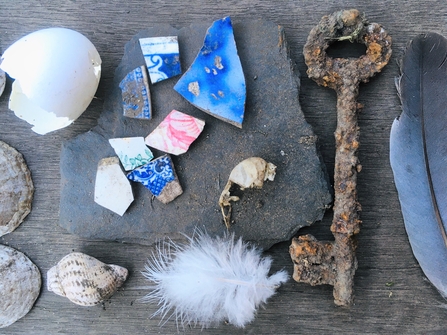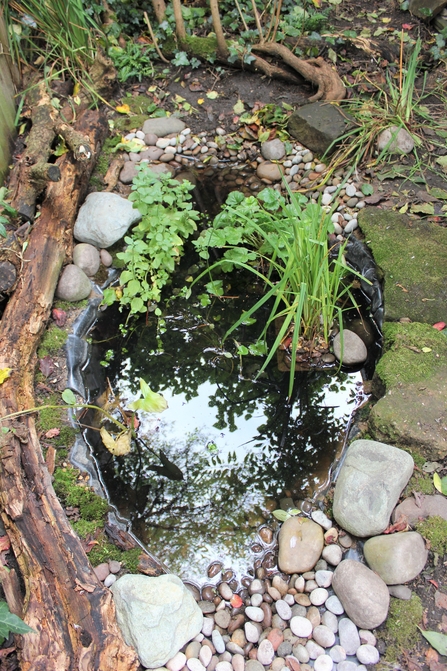Back in the spring, when we first started to think about making a pond, we put together some images of wildlife ponds we liked. Our favourite picture had a shallow pebbled area, long grass and flowers growing around some larger rocks. So when it came to landscaping the big puddle we’d created, that photo was our starting point.
The Shepherds' Pond Project - Part 3
The Shepherd family pond's cobble slopes
Some of the cobbles and an old branch on the edge of the pond
A terracotta pot, useful as shelter for amphibians
As it turns out, we’ve been planning our ‘one day…’ pond for years. Old tree branches, mossy stones and cobbles have been saved in the corner of the garden and could now be used to make a wildlife friendly habitat. One tree branch curved so perfectly around the edge of the pond it looked as if we had designed it that way (we hadn’t). Stones dug up during the build were reused along with a few old terracotta pots that we partially sunk into the ground - they make great amphibian shelters.

Various curiosities found around the Shepherds' pond area
We found a few unexpected treasures along the way as well: some bones (respectfully reburied), broken pottery and glass, rusted metal wire and a big, old rusty key, which were all intriguing and reminded us that we’re just one chapter in the garden’s story.
Once the branches and stones were positioned around the edge of the pond, we started to build up the sloping sides with cobbles and smaller pebbles so there were several entry and exit points. We added some aquatic soil to the bottom and filled in some of the gaps around the edge where the liner was still visible with soil and moss to make it look more natural and established.
The Shepherd family pond's cobble slopes
We bought four plants to start with, all native to the UK and suited to the shallower emergent and marginal areas of the pond, but at differing depths. We used the Wildlife Trust’s pond plant guide which lists recommended plants for all four zones. We chose Water Avens, Arrowhead, Greater Pond-sedge and Water Mint for a variety of height and cover, which will hopefully attract a good range of insects.
A look at the plantlife in the Shepherds' pond
Around the edge of the pond we added a few ferns and irises and we are going to lay some wildflower turf to create an area with longer grass, which is ideal for amphibians as well as bees, butterflies, moths and other insects. Behind the pond, in the corner next to the lilac tree, we have piled up some logs and leaves for insects, frogs and toads to shelter in.
From puddle to pond in just a few weeks - with no previous pond making experience between us we have managed to create a little wildlife haven in an unused corner. Not only will it benefit the insects, amphibians, birds and small mammals that live in and visit our garden but it has also had a big impact on us as a family. Working together on a shared project has been really enjoyable over the summer and we’ve combined our different skills, and learnt some new ones, to improve our own habitat. That unused corner now looks so much better and it will really come into its own when everything starts to grow in the spring. There is also a real sense of pride and achievement that we have created something from scratch and finally, after talking about it for so long, have our own little pond.

A top-down view of the finished pond
Autumn or late winter is the best time to make a pond – the soil isn’t too wet or dry and it will get established much quicker, ready for spring. So why not make your own pond, big or small, and do something wonderful for wildlife.

